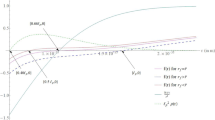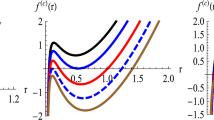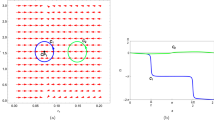Abstract
The interactions between spin of fermionic matter and torsion in Einstein–Cartan–Sciama–Kibble (ECSK) theory of gravity provide a repulsive gravitational potential at very dense states of fermionic matter, which prevents the formation of black hole singularities inside the deeper horizon. While the fermionic matter in the black hole is attracted by the black hole at the beginning, after a critical point it is repelled to bounce at a critical high density and then expand into other side of the horizon as a newly created space, which may be considered as a non-singular, closed universe. We constructed the action of these fermions in a black hole with torsion in the framework of ECSK theory of gravity from which the free Dirac action is inferred and the interaction potential is obtained. Also, this scenario naturally solves the flatness and horizon problems of cosmology without introducing finely tuned scalar fields, or more complicated functions of the Ricci scalar R in gravitational action.


Similar content being viewed by others
References
E A Lord, Tensors, Relativity and Cosmology (New York: McGraw-Hill) (1976)
T W B Kibble J. Math. Phys. 2 212 (1961)
D W Sciama Rev. Mod. Phys. 36 463 (1964)
D W Sciama Rev. Mod. Phys. 36 1103 (1964)
F W Hehl Phys. Lett. A 36 225 (1971)
F W Hehl Gen. Relativ. Gravit. 4 333 (1973)
F W Hehl Gen. Relativ. Gravit. 5 491 (1974)
F W Hehl, P von der Heyde and G D Kerlick, J M Nester Rev. Mod. Phys. 48 393 (1976)
F W Hehl and B K Datta J. Math. Phys. 12 1334 (1971)
V de Sabbata and M Gasperini Introduction to Gravitation (Singapore: World Scientific) (1985)
V de Sabbata and C Sivaram Spin and Torsion in Gravitation (Singapore: World Scientific) (1994)
J A Schouten Ricci-Calculus (Berlin: Springer-Verlag) (1954)
I L Shapiro Phys. Rep. 357 113 (2002)
R T Hammond Rep. Prog. Phys. 65 599 (2002)
T P Sotiriou and V Faraoni Rev. Mod. Phys. 82 451 (2010)
S Capozziello and M de Laurentis Phys. Rept. 509 167 (2011)
N J Poplawski ApJ 832 96 (2016)
N Poplawski arXiv:1304.0047 (2013)
N J Poplawski arXiv:0911.0334 (2009)
W Kopczyński Phys. Lett. A 39 219 (1972)
W Kopczyński Phys. Lett. A 43 63 (1973)
A Trautman Nature Physical Science 242 7 (1973)
F W Hehl Gen. Relativ. Gravit. 5 491 (1974)
M Gasperini Phys. Rev. Lett. 56 2873 (1986)
S D Brechet, M P Hobson and A N Lasenby CQGra 25 245016 (2008)
N J Poplawski Phys. Lett. B 687 110 (2010)
N Poplawski Phys. Rev. D 85 107502 (2012)
N J Poplawski Phys. Lett. B 727 575 (2013)
J Magueijo, T G Zlosnik and T W B Kibble Phys. Rev. D 87 063504 (2013)
S Alexander, C Bambi, A Marcianò and L Modesto Phys. Rev. D 90 123510 (2014)
C Bambi, D Malafarina, A Marcianò and L Modesto Phys. Lett. B 734 27 (2014)
B Kuchowicz Gen. Rel. Grav. 9 511 (1978)
L C Garcia de Andrade NCimB 116 1107 (2001)
N J Popławski Phys. Lett. B 694 181 (2010)
N J Popławski Phys. Lett. B 701 672 (2011)
N J Popławski Gen. Relativ. Gravit. 44 1007 (2012)
N Popławski Astron. Rev. 8 108 (2013b)
D Kazanas ApJL 241 L59 (1980)
A H Guth Phys. Rev. D 23 347 (1981)
A Linde Phys. Lett. B 108 389 (1982)
N. J. Poplawski, Phys. Lett. B 690 73 (2010)
T Stachowiak and M Szydłowski Phys. Lett. B 646 209 (2007)
M Novello and S E Perez Bergliaffa Phys. Rev. 463 127 (2008)
D Battefeld and P Peter Phys. Rev. 571 1 (2015)
R Brandenberger and P Peter arXiv:1603.05834 (2016)
I D Novikov JETPL 3 142 (1966)
R K Pathria Nature 240 298 (1972)
V P Frolov, M A Markov and V F Mukhanov Phys. Lett. B 216 272 (1989)
V P Frolov, M A Markov and V F Mukhanov Phys. Rev. D 41 383 (1990)
L Smolin Class. Quantum Grav. 9 173 (1992)
W M Stuckey American J. Phys. 62 788 (1994)
D A Easson and R H Brandenberger JHEP 06 024 (2001)
J Smoller and B Temple PNAS 100 11216 (2003)
M. Forger and H. Römer, Annals of Physics 309 306 (2004)
Y N Obukhov, V N Ponomarev and V V Zhytnikov, Gen. Rel. Grav. 21 1107 (1989)
Y N Obukhov Int. J. Geom. Meth. Mod. Phys. 3 95 (2006)
S M Christensen, J. Phys. A: Math. Gen. 13 3001 (1980)
H Shabani and A HadiZiaie Int. J. Mod Phys. A 33 1850095 (2018)
L Zhang, S Chen and J Jing Int. J. Mod Phys. D 27 1850110 (2018)
S Chen, L Zhang and J Jing Eur. Phys. J. C 78 981 (2018)
A Ovgun and İ Sakalli Class. Quantum Grav. 37 225003 (2020)
L Parker Phys. Rev. D 3 346 (1971)
L Parker Phys. Rev. D 3 2546 (1971)
Y B Zel’dovich JETPL 12 307 (1970)
Y B Zel’dovich and A A Starobinskii JETPL 26 252 (1977)
Author information
Authors and Affiliations
Corresponding author
Additional information
Publisher's Note
Springer Nature remains neutral with regard to jurisdictional claims in published maps and institutional affiliations.
Rights and permissions
About this article
Cite this article
Dil, E. Interaction of fermionic matter and ECSK black hole leading to bouncing universe. Indian J Phys 96, 3031–3037 (2022). https://doi.org/10.1007/s12648-021-02200-3
Received:
Accepted:
Published:
Issue Date:
DOI: https://doi.org/10.1007/s12648-021-02200-3




